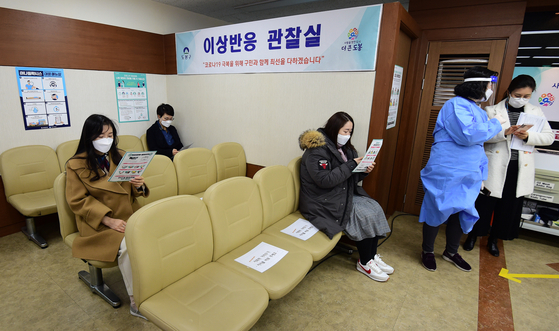![On the 26th of last month, when vaccination for the novel coronavirus infection (Corona 19) began, a nursing hospital and nursing facility workers at the Dobong-gu public health center in Seoul are waiting in the adverse reaction observation room after receiving the AstraZeneca (AZ) vaccination. [뉴스1]](https://i0.wp.com/pds.joins.com/news/component/htmlphoto_mmdata/202103/02/e69531c8-8ee8-4607-ba8a-e0285482112a.jpg?w=560&ssl=1)
On the 26th of last month, when vaccination for the novel coronavirus infection (Corona 19) began, a nursing hospital and nursing facility workers at the Dobong-gu public health center in Seoul are waiting in the adverse reaction observation room after receiving the AstraZeneca (AZ) vaccination. [뉴스1]
Four additional reports of adverse reactions caused by the novel coronavirus infection (Corona 19) vaccine were received a day. All reported cases were mild symptoms such as headache and muscle pain.
According to the Central Defense Countermeasure Headquarters (Bang Dae-bon) on the 2nd, 4 people who reported adverse reactions the day before were vaccinated with AstraZeneca (AZ), all of which were confirmed as mild cases that can be common after vaccination.
As a result, there were 156 cases of cumulative adverse reactions for five days after the start of vaccination on the 26th of last month. As of 0 o’clock on this day, it is 0.68% of the total of 23,086 inoculations. Suspicious symptoms of adverse reactions were all mild cases, such as fever, muscle pain, headache, nausea, chills, and dizziness above 38 degrees, and there were no serious adverse reactions.
When looking at the report rate of adverse reactions by vaccine type, 155 of the 2191 cumulative AstraZeneca vaccinations were 0.7%. For Pfizer vaccine, 1 out of 895 cumulative vaccinations (0.11%) reported suspected adverse reactions. This difference appears to be due to the cumulative number of AstraZeneca vaccinations far exceeding those of Pfizer vaccinations.
The most worrisome side effects after vaccination are anaphylaxis, which is accompanied by shock, shortness of breath, loss of consciousness, and swelling of the lips and mouth. Anaphylaxis, which is most concerned about, is at a very low incidence level, but even if it does occur, it usually occurs within 30 minutes after vaccination.
In addition, the quarantine authorities plan to actively monitor adverse reactions that may occur following the introduction of new vaccines through various surveillance systems.
Reporter Dayoung Kim [email protected]
![]()
